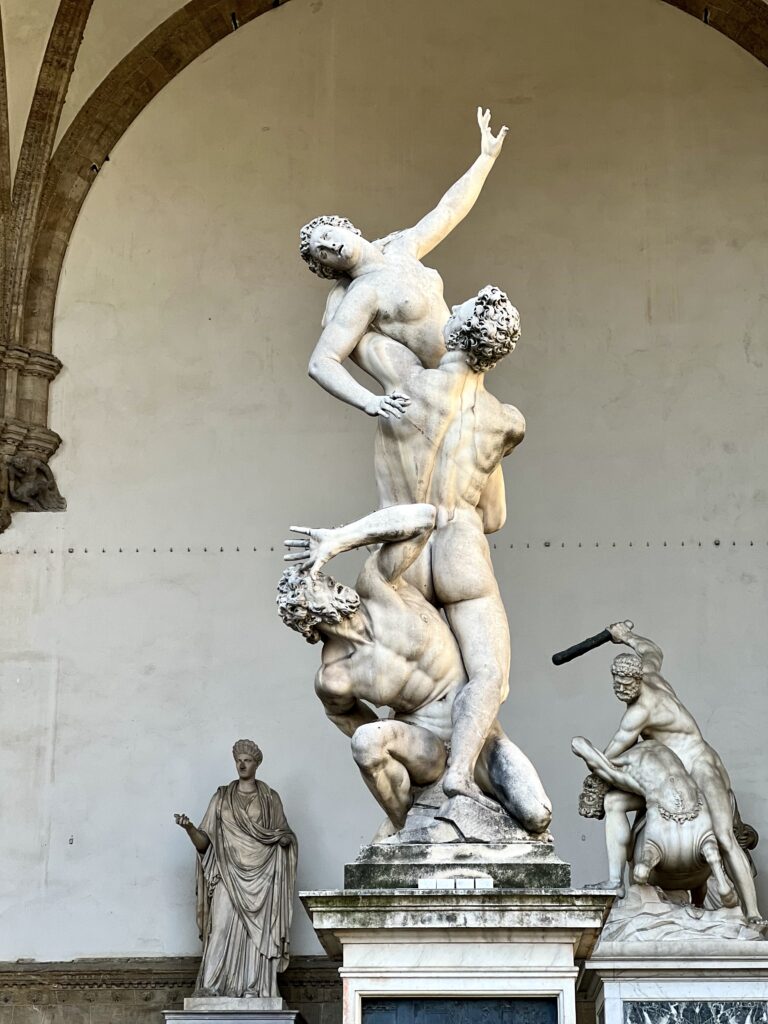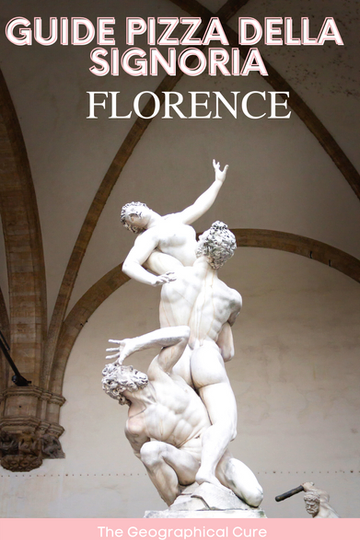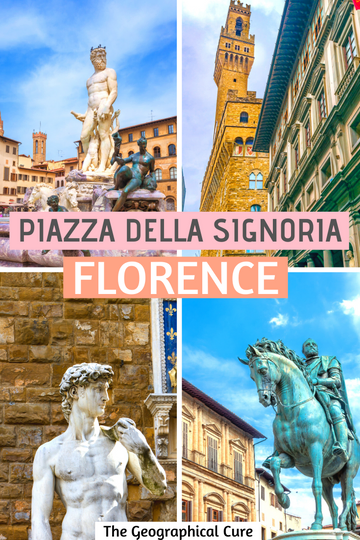Here’s my guide to visiting the Piazza della Signoria, the most famous square in Florence Italy.
The streets of Florence are graced with amazing sculpture and artworks almost everywhere you look.
But the jackpot of outdoor street art is the Piazza della Signoria. The piazza is filled with sculptures by the greatest artists of the Renaissance.
The best part? It’s all free.
The Piazza della Signorina is also the home of Palazzo Vecchio — the former seat of Florence’s government and now a museum. It was once the center of Florentine life and politics, a meeting spot buzzing with activity.
Many beautiful sculptures by Italy’s greatest artists are on display in front of the Palazzo Vecchio or adjacent to it in the Loggia dei Lanza.
The loggia is a beautiful arched gallery built in the 14th century. It adjoins the famed Uffizi Gallery. Originally, the loggia was used to host public meetings and hold ceremonies. Later, it was transformed into an outdoor sculpture gallery.
Each statue in the Piazza della Signoria represents a different chapter in Florence’s long history. The statues tell stories of murder, rape, religion, mythology, and key moments in art history.
At first, the reigning Medici family were reluctant to put statues in front the Palazzo Vecchio. They feared their rivals might use them as battering rams on the palace. But as the Medici’s power and influence grew, they began to decorate the Piazza della Signorina.
It was a politically astute move. The Medici effectively turned a political hub into an outdoor museum, all the better to make the people comfortable with their wielding of power.
Guide To The Piazza Della Signoria: What To See
Here are the must see sculptures and statues in the Piazza della Signoria.
1. Donatello, Marzocco, 1416
In 1416, Donatello’s Marzocco was the first statue placed in the Piazza della Signoria. Carved by the greatest artist of the time, it was symbolic. The statue is a gray lion.
His paw is on a shield with a red fleur de lis on a white background. That’s Florence’s flag and a symbol of the citizen militia.
Though Florence was a powerful economic and cultural center, it wasn’t a military power and didn’t have a standing army. Florence viewed itself as an underdog in all the regional skirmishes and wars. If Florence was threatened, it sounded a gong. The citizens came forward with their swords and weapons to defend the city.
The original Marzocco is now in the Bargello Museum. The Bargello is to sculpture what the Uffizi is to painting.
2. Donatello, Judith and Holofernes
The second statue placed in the square couldn’t be more different. It was an avant garde piece also carved by Donatello that portrays a violent biblical scene.
It’s the Old Testament story of Judith and Holofernes, in which a heroic woman defeats a warlord who’s besieged her town in Israel. She does this by seducing, inebriating, and decapitating him.
In the statue, Judith isn’t portrayed as virtuous, delicate, or almost disgusted by her murderous task. No, Judith completely dominates Holofernes. She’s almost straddling him. There’s a gash in his neck.
Judith and Holofernes carried forth the Medici’s underdog theme. The statue was first placed in the Medici garden. When the Medici had a short exile from the city, the citizens moved the statue into the Piazza della Signoria.
3. Michelangelo, David
When the Medici returned from exile, they replaced Judith and Holofernes with what is probably the world’s most famous sculpture, Michelangelo’s commanding statue of David.
The 17 foot sculpture is considered the embodiment of male beauty, a Calvin Klein-like model of physical perfection. Legend hold that, when Michelangelo was sculpting, he crashed a hammer into the piece shouting “Why will you not speak?”
David was originally commissioned for Florence Cathedral. The city intended to place the statue high above in a niche. But they decided that David was too beautiful for that location. Instead, David was placed outside the entrance to the Palazzo Vecchio and the city adopted David as its mascot.
Michelangelo’s version of the David and Goliath tale departs from traditional depictions. Previously, David was carved in a more spiritual and scholarly manner holding scrolls. In the Renaissance, David was transformed into a superhero action figure.
Michelangelo’s David shows the moment before the battle. In the biblical tale, David is an underdog, entering the battle with only 5 stones and slingshot against a Goliath double his size. As we all know, David wins the battle, saves Israel, and decapitates Goliath.
David remained in the Piazza della Signoria for 369 years. Originally, parts of David were gilded. But the gilded surfaces were lost during the statue’s exposure to the elements.
In 1873, David was moved inside to the Galleria dell’Accademia, one of Florence’s must see museums. A copy was put in its place, which you see today. There’s also a copy of David in the Piazzale Michelangelo.
READ: Seeing Michelangelo’s David at the Galleria dell’Academia
4. Cellini, Perseus
Cellini’s Perseus is one of the Renaissance’s most famous sculptures. Cellini was a goldsmith by profession.
Perseus was his defining piece. And it’s the original that you see today in the Loggia dei Lanza in the Piazza della Signoria. (Hopefully, it will be moved inside for preservation soon.)
Perseus was commissioned by the Medici, who considered perseus their founding father. Perseus tells the story of Perseus saving Athens from the petrifying glare of the Gorgon Medusa. Perseus was also an underdog, tricked into attempting to kill Medusa against incredible odds.
According to the poet Ovid, Medusa was renowned for her loveliness. But when Poseidon raped her in the Temple of Athena, Athena was ticked off. She transformed Medusa’s glorious mane of hair into snakes — a symbol of female rage.
This way, when Medusa’s enemies saw her, they were numbed with fear and turned to stone. Medusa became both a beautiful victim and a monstrous villain, put to use by Perseus.
In Cellini’s rendition of the myth, Perseus yields a phallic sword to vanquish Medusa. Perseus stands triumphant, holding aloft Medusa’s severed head.
Cellini signed his name across Perseus’ sash, in the same way that Michelangelo signed his Pieta at St. Peter’s Basilica in Rome.
Medusa’s head is a portrait of Cellini’s lover. He tricked her into posing for him, to her dismay. Cellini places his own bearded portrait between the wings of Perseus’ crown.
Interestingly, Cellini wrote an autobiography. He glamorized himself as a swashbuckling womanizer. Cellini claimed that Michelangelo told him he was the next best sculptor after Michelangelo.
When Perseus was placed in the square, the Medici decided to place Judith and Holofernes back in the square. A kind of chi and been achieved with both a man and a woman decapitating their victims.
5. Baccio Bandinelli, Hercules and Cacus
Have you ever heard of Bandinelli? I hadn’t. His name isn’t terribly renowned. But he wasn’t an insignificant sculptor of the Renaissance either.
Commissioned by the Medici, this statue of Hercules and Cacus, the original, stands in a place of honor opposite David at the entrance of the Palazzo Vecchio. Hercules was a demi-god and an important hero in Greek mythology. He’s an embodiment of physical strength, masculinity, and courage.
Hercules’ life was full of adventure. In one, Hercules killed the fire breathing monster Cacus. Cacus had killed Hercule’s cattle. Bandinelli’s statue shows the moment just after Hercules throws Cacus to the ground.
Thes statue was roundly criticized, especially by historian and architect Giorgio Vasari. The Florentine citizens called it a “sack of potatoes” and threw stones at it. Everyone hated it except for the Medici, who thought the burly statue showed the might of dukedom.
Hercules appears ripped and bulging, especially his back, like steroids gone bad. When the statue was restored in 1994, restorers discovered that Hercule’s club had been stolen and replaced with an aluminum copy.
Bandinelli’s statue also doesn’t have the dynamism of other statues in the piazza. The two figures stand in stony silence. Neither figure expresses any emotion or exudes the illusion of movement.
6. Bartolomeo Amanatti, Neptune’s Fountain
Commissioned to celebrate a Medici marriage, the Fountain of Neptune sports a colossal statue of Neptune, the Roman god of the sea and the counterpart of the Greek god Poseidon. The commission was given to a student of Michelangelo’s, Amanatti.
Made of white Carrera marble, Neptune is given the face of the cunning Cosimo de Medici. The chained sea monster represents Florentine dominance at sea. Two bronze statues by Giambologna, depicting a satyr and nymph, sit on the edge of the basin.
Neptune was a lascivious sort, with many wives and lovers. Neptune was the one who raped Medusa and started the petrifying problem. Interestingly, Neptune is looking directly at Cellini’s Medusa, only a few yards away in the Loggia dei Lanza.
The citizens hated Neptune as much as Hercules and Cacus. They had grown accustomed to the superb sculptures of Donatello and Michelangelo.
They didn’t cotton to the second wave of Renaissance sculptures as much, especially those that didn’t use a classical style. Neptune looks like an NFL linebacker, not a classical god.
The citizens nicknamed Neptune “Il Biacone,” which translates roughly to big white dude. To show their distaste, they treated Amanatti’s work like a public fountain, not a work of art. They peed in it, used it as a wash basin, and vandalized it.
In the piazza, there’s a marble plaque marking this moment of history. The plaque instructs citizens not to desecrate the statue or risk fines. The city never removed the plaque. So it sits as a reminder of the Florentine protest.
In 1830, the Gaimbologna satyr was stolen during a carnival. Its location is still unknown. In 2005, a vandal climbed on Neptune and ripped off an arm. As a result, the original statue of Neptune is safely in the Bargello Museum.
The Neptune Fountain isn’t used as a fountain anymore. But it was recently cleaned and is now lit up dramatically at night.

7. Giambologna, Rape of the Sabine Women
Despite Cellini’s claims, Giambologna was the most important sculptor in Florence after Michelangelo. In fact, he was the greatest sculptor of the second half of the 16th century.
Giambologna was a court sculptor to the Medici. The Medici valued his work so much they even forbade Giambologna from leaving Florence. They feared he would be permanently coopted by foreign employers.
Gaimbologna was influenced by Michelangelo, but developed his own late Renaissance Mannerist style. The Mannerists used graceful curves, sinuous lines, and artificially exaggerated poses. Their work has a sort of hyper-elegance. The focus is on beauty, not emotion.
In this sculpture, Gaimbologna depicts the Rape of the Sabines, part of the foundation myth of Rome. Romulus and Remus were the founders of Rome. But they disagree about exactly where to live.
Romulus killed Remus and settled on Palatine Hill, were you can still find the ancient ruins of Romulus’ hut. But Romulus realized his army consisted only of men, not conducive to expanding the city’s size. So he abducted, i.e. “raped,” some women from the nearby Sabine tribe.
In Giambologna’s sculpture, three figures are connected in serpentine-like movement that’s best seen in 360 degrees. A Roman man captures a Sabine woman as he marches over a vanquished and crouching Sabine man. The woman twists backward as she’s hoisted in the air.
You can see the man’s fingers pressing into the woman’s thigh. This detail would influence the subsequent Baroque master, Gian Lorenzo Bernini. The same thigh indentations are found in his epic sculpture, The Rape of Persephone, in Rome’s Borghese Gallery.
Rape of the Sabines was Giambologna’s last major work and his defining masterpiece. And it was the product of oneupmanship. Michelangelo had sculpted two figures from a block of marble. Gaimbologna decided to carve three.
When created, the sculpture had no name. But Giambologna’s patron insisted that it have a theme. So Giambologna rather randomly chose the Rape of the Sabines. The statue has recently been cleaned and restored.
8. Giambologna, Cosimo de Medici Equestrian Monument
After the success of Rape of the Sabines, Giambologna received other commissions for monumental sculpture.
One was the equestrian monument in the Piazza della Signoria. Giambologna executed it in the grand style of equestrian monuments, reminiscent of the one to Marcus Aurelius in the Piazza del Campidoglio in Rome.
The horse’s billowing mane contrasts with its static body. The grand duke governs his horse, reigns lightly tensed, as he governs his state. The base of the statue has a relief showing the life of Cosimo de Medici.
This statue was so popular that Giambologna and his workshop received many similar commissions. In fact, they created most of the equestrian monuments from the first half of the 17th century.
9. Giambologna, Hercules and the Centaur Nessus
This magnificent sculpure also sits in the Loggia dei Lanza. Impressively, it was carved from a single block of marble. It’s an evocative symbol of the strength of mortal man.
Like Rape of the Sabines, there’s no primary viewpoint. Walk around it for the best experience. Hercules is depicted in the statue beating Nessus the centaur, who tried to steal Hercule’s wife. Later, Hercules would be killed by the poisoned blood of the dead centaur.
The statue is done in Giambologna’s typical refined style, with plenty of action. Rotating his body like a fulcrum, Hercules pins down the centaur while swinging his club.
The centaur collapses and screams, his neck twisted back in an unnatural position. It’s a classic of Mannerist sculpture.
10. Plaque of Savonarola Execution
Another key moment in Florence’s history was the rise of the fiery Dominican preacher Girolamo Savonarola from San Marco Monastery. Savonarola denounced the excesses of clerical and despotic power.
He told Florentines the apocalypse was coming and to save themselves through self censorship. When Charles VII of France invaded Florence, the citizens thought his sermons prophetic.
The doomsday preacher eventually ousted the Medici and established a theocracy in Florence. He hated Florence’s nude sculptures, which to his mind’s eye represented sin. In the 1497 “Bonfire of the Vanities,” Savonarola destroyed works of art in the Piazza della Signoria.
READ: History of the Medici Dynasty
But Savonarola went too far. He began to preach that he could perform miracles. In 1498, when Savonarola delayed a trial by fire in the Piazza della Signoria, the pleasure loving citizens of Florence had had enough.
Savonarola was defrocked and imprisoned in the Palazzo Vecchio for heresy. After being tried and convicted, he was executed in the Piazza della Signoria. A circular plaque near the Palazzo Vecchio’s entrance marks the spot of Savonarola’s execution.
11. Lions of the Loggia dei Lanza
As you approach the loggia, you’re greeted by two huge marble lions, referred to as the Medici lions, with their paw on a sphere.
One lion dates from ancient Rome. The other was sculpted in 1598 by Flaminio Vacca. It was originally in the Villa Medici in Rome before being moved to the loggia.
I hope you’ve enjoyed my guide to Florence’s beautiful Piazza Della Signoria. You may enjoy these other Florence travel guides and resources:
- 1 day itinerary for Florence
- 2 day itinerary for Florence
- 3 day itinerary for Florence
- Best museums in Florence
- Hidden gems in Florence
- Must see sites in Florence
- Florence art bucket list
- Best day trips from Florence
- Guide to the Medici Palaces
- Guide to the Uffizi Gallery
- How To Visit the Florence Duomo
- Guide to Santa Croce Cathedral Complex
If you need a guide to the Piazza della Signoria, pin it for later.



This was helpful, thanks!
You’re welcome! Enjoy!
Loved this guide as we visited the square last week. Also Neptune’s fountain is functioning again! Was beautiful. Thanks for this great history!
Glad you enjoyed it Leigha!